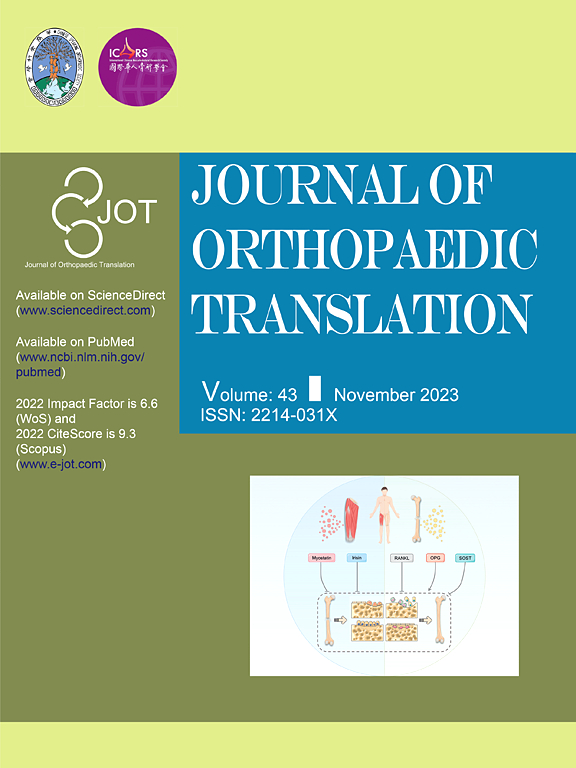Vibration therapy as an intervention for trochanteric hip fractures – A randomized double-blinded, placebo-controlled trial
IF 5.9
1区 医学
Q1 ORTHOPEDICS
引用次数: 0
Abstract
Background
Hip fractures are one of the most serious forms of fragility fractures. Low-magnitude high-frequency vibration (LMHFV) is a biophysical intervention that provides non-invasive, systemic mechanical stimulation. The objectives of this study were to investigate the efficacy of LMHFV in trochanteric hip fracture elderly patients to (i) accelerate trochanteric fracture healing and (ii) improve clinical and functional outcomes.
Methods
A randomized double-blinded, placebo-controlled clinical trial was conducted. Participants were randomly assigned into LMHFV or placebo intervention for 14 days. Primary outcome assessments were fracture healing assessed with CT scan and X-rays. Dual X-ray Absorptiometry (DXA) scan was performed to assess bone mineral density change. Secondary outcome assessments were clinical and functional outcomes with quadriceps muscle strength, balancing ability, handgrip strength, Time Up and Go (TUG) test, quality of life outcomes, pain, falls, and mortality.
Results
237 patients were screened for eligibility by the inclusion and exclusion criteria. 62 patients were recruited and randomly assigned to placebo group (n = 32, mean age: 83.6 ± 7.0 years, women: 71.9 %) or LMHFV group (n = 30, mean age: 81.5 ± 5.7 years, women: 73.3 %). For fracture healing, CT scan at 6 weeks showed improved osseous union for the LMHFV group at 71.5 ± 19.4 % compared to placebo group at 58.8 ± 30.5 %, but no statistical significance detected. X-rays showed fractures healed at 12 months. LMHFV group had significantly higher quadriceps muscle strength compared to placebo group on affected leg using maximum reading (week 26: 8.8 ± 3.6 kg vs. 6.1 ± 4.1 kg; p = 0.011) and average reading (week 26: 8.0 ± 3.7 kg vs. 5.2 ± 3.3 kg; p = 0.008) amongst 3 trials. The balancing ability test could not be performed in most of the subjects at the baseline measurement. However, from week 6 to week 26, LMHFV group had significantly improved balancing compared to placebo group for overall stability index (week 26: 1.6 ± 1.1 vs. 3.4 ± 2.6; p = 0.006), anteroposterior stability index (week 26: 1.1 ± 0.7 vs. 2.1 ± 1.9; p = 0.048) and medial-lateral stability index (week 26: 0.9 ± 0.7 vs. 2.2 ± 2.2; p = 0.008). There was a significant increase in success in performing TUG test in LMHFV group from baseline (13.3 %) to 26 weeks (57.1 %) (p = 0.004). Quality-of-life outcomes by SF-36 showed LMHFV group had a significant improvement at a score of 62.1 ± 18.9 compared to control group at a score of 48.5 ± 18.9 after adjusting for the baseline measurement (p = 0.044).
Conclusion
A short duration of LMHFV during in-patient stay can improve clinical outcomes and can potentially be incorporated as a practical measure during the recovery of fragility hip fractures.
The translational potential of this article
14 days of LMHFV treatment is generally within the common in-patient stay period for hip fracture patients and therefore can potentially be incorporated into clinical practice with physiotherapy to facilitate recovery of hip fracture patients.
Clinical trial registration number
NCT04063891.

振动疗法对髋粗隆骨折的干预——一项随机、双盲、安慰剂对照试验
背景:髋部骨折是脆性骨折最严重的形式之一。低震级高频振动(LMHFV)是一种生物物理干预手段,可提供无创的全身机械刺激。本研究的目的是探讨LMHFV在老年股骨粗隆骨折患者中的疗效:(1)加速股骨粗隆骨折愈合;(2)改善临床和功能预后。方法采用随机、双盲、安慰剂对照的临床试验。参与者被随机分配到LMHFV或安慰剂干预14天。主要结果评估是通过CT扫描和x射线评估骨折愈合。双x线吸收仪(DXA)扫描评估骨密度变化。次要结局评估是临床和功能结局,包括股四头肌力量、平衡能力、握力、Time Up and Go (TUG)测试、生活质量结局、疼痛、跌倒和死亡率。结果237例患者符合纳入和排除标准。共招募62例患者,随机分为安慰剂组(n = 32,平均年龄:83.6±7.0岁,女性:71.9%)和LMHFV组(n = 30,平均年龄:81.5±5.7岁,女性:73.3%)。对于骨折愈合,6周CT扫描显示LMHFV组骨愈合改善率为71.5±19.4%,而安慰剂组为58.8±30.5%,但无统计学意义。x光显示骨折在12个月时愈合。与安慰剂组相比,LMHFV组在受影响的腿上使用最大读数具有显著更高的股四头肌力量(第26周:8.8±3.6 kg vs 6.1±4.1 kg;P = 0.011)和平均读数(第26周:8.0±3.7 kg vs. 5.2±3.3 kg;P = 0.008)。大多数受试者在基线测量时无法进行平衡能力测试。然而,从第6周到第26周,与安慰剂组相比,LMHFV组的整体稳定性指数显著改善(第26周:1.6±1.1 vs. 3.4±2.6;P = 0.006),前后位稳定性指数(第26周:1.1±0.7 vs. 2.1±1.9;P = 0.048)和中外侧稳定性指数(第26周:0.9±0.7 vs. 2.2±2.2;p = 0.008)。从基线(13.3%)到26周(57.1%),LMHFV组进行TUG测试的成功率显著增加(p = 0.004)。SF-36的生活质量结果显示,调整基线测量后,LMHFV组的生活质量得分为62.1±18.9,而对照组的生活质量得分为48.5±18.9 (p = 0.044)。结论住院期间短时间的LMHFV治疗可改善临床疗效,可作为脆性髋部骨折康复的一项实用措施。14天的LMHFV治疗通常在髋部骨折患者的常见住院时间内,因此有可能与物理治疗结合到临床实践中,以促进髋部骨折患者的康复。临床试验注册号:bernct04063891。
本文章由计算机程序翻译,如有差异,请以英文原文为准。
求助全文
约1分钟内获得全文
求助全文
来源期刊

Journal of Orthopaedic Translation
Medicine-Orthopedics and Sports Medicine
CiteScore
11.80
自引率
13.60%
发文量
91
审稿时长
29 days
期刊介绍:
The Journal of Orthopaedic Translation (JOT) is the official peer-reviewed, open access journal of the Chinese Speaking Orthopaedic Society (CSOS) and the International Chinese Musculoskeletal Research Society (ICMRS). It is published quarterly, in January, April, July and October, by Elsevier.
 求助内容:
求助内容: 应助结果提醒方式:
应助结果提醒方式:


